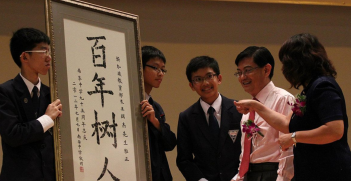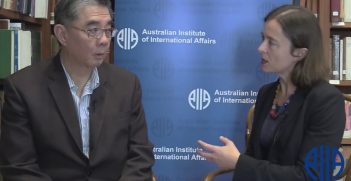The Constitutionalisation of Religious Harmony in Singapore

Religiosity and religious diversity are core elements of Singapore’s national identity. To address societal instability, political dissent, religious extremism, and violence, Singapore has transformed the concept of “religious harmony” into a constitutional norm.
On the eve of Racial Harmony Day in 2017, Singaporean Prime Minister Lee Hsien Loong wrote on Facebook, “Singapore is a rare and precious example of a multi-racial, multi-lingual and multi-religious society where people live harmoniously together. This is not by chance.” The promotion of religious harmony in Singapore stems from an enduring perceived threat that civic allegiance to the Singaporean nation-state would come in second place to individual religious and ethnic loyalties.
Managing religious and ethnic heterogeneity, particularly given the strong sense of religiosity in practice and proselytisation of faith among Singaporeans of all denominations, has been a focus of Singaporean leaders since decolonisation, separation from Malaysia, and the early years of independence. More recent concerns that Southeast Asia was becoming the “second front” in the war against international terrorism, as well as increased societal tensions arising from heightened scrutiny of the Muslim community, have generated support for the securitisation of “religious harmony” within Singapore’s legal landscape.
The invocation of religious harmony reflects its character as an aspirational norm in Singapore’s adoption of laws seeking to regulate religion and interreligious coexistence. Definitions of religious harmony emphasise the “harmonious and common development… of mutual understanding and empathy” within and between religions, religious communities, and broader society. They highlight the imperative of enhancing shared commitments to peace and tolerance among religious communities. This preference for collectivism over individualism underpins the concept of harmony in Asian societies and is underscored by the consistent emphasis that personal religious beliefs and practices “should not be at the expense of religious harmony.”
As a legal, political, and social norm in Asian countries, religious harmony is often used to justify the need to manage religious diversity through the imposition of legal obligations. In this sense, religious harmony is the pursuit of public order in a pluralistic society, rather than a “meaningful form of intermingling” or a “strong sense of community and solidarity among the different religious groups.”
In Singapore, religious harmony as a fundamental social norm and emerging quasi-constitutional principle stems from the state’s spiritually pluralistic society. As a “nation of believers,” faith is integral to Singapore’s cultural identity. 43.2 percent of Singapore’s population is Buddhist or Taoist, making this the largest religious group in the state. Christianity accounts for 18.7 percent, Islam 14 percent, Hinduism five percent, other religions 0.6 percent. Approximately 18.5 percent of Singaporeans identify as having no religion. While there is a tendency to view Singaporean law and society through the “saliency of ethnic consciousness,” (i.e. an awareness of belonging to an ethnic group), racial and religious identities in Singapore are often conflated. This “double bond of race and faith” is the consequence of the synonymous recognition of, for example, Malay-Singaporeans as Malay-Muslim.
Persistent political and social tensions between Malay and Chinese Singaporeans characterised the nation’s journey to separation from Malaysia in 1965. Escalating tension between Singapore’s People’s Action Party and the Malaysian central government set the tone for political strife defined by ethnic polarisation. This eventually deteriorated into riots between these groups with the onset of violence coinciding with celebrations of the Prophet Muhammad’s Birthday. The pre-independence race riots of 1964 have since been woven into a narrative of vulnerability to destabilisation along religious and racial fault lines. Managing this fragility through regulatory legal mechanisms and the promotion of the fundamental state principles of racial and religious tolerance is therefore seen as essential for preserving regime legitimacy and a sense of Singaporean nationhood.
Religious plurality as a critical national security challenge has sharpened with the threat of international and homegrown terrorism in Singapore. Mounting fears of Muslim self-radicalisation were precipitated by the arrest and detention of Jemaah Islamiyah (JI) terrorist suspects beginning in 2001. The discovery of a presence of self-radicalised terrorists in Singapore around the same time as the September 11 terrorist attacks in the United States resulted in the securitisation of Muslim religiosity and religious expression in Singapore. Along with the belief in a rising religious conservativism among Singaporean Muslims, these events strained ethnic/religious relations in Singapore and confirmed longstanding governmental anxieties regarding Singaporean Muslims’ loyalty to the state.
The constitutionally-entrenched regulating principle of religious harmony has been invoked through the law to enhance Singapore’s authority to socialise and control the body politic through legal and socio-political obligations. In practice, this has seen the introduction of legislation and softer declarations of aspirational state ideals which obligate and persuade citizens to promote harmony and tolerance between religious groups.
Singapore’s Maintenance of Religious Harmony Act (MRHA), passed in 1990 and amended late last year to further consolidate powers under the act, reflects the government’s perception of aggravated inter-religious tension, “aggressive proselytization,” and the politicisation of religion as rising threats. According to the White Paper introducing the bill, the MRHA sought to target the exploitation of “religion for political and subversive purposes.” In particular, the government sought to prevent “religious strife” arising from the perceived political threat of over-zealous Christian evangelising.
The MRHA established the Presidential Council for Religious Harmony, of which two-thirds of the members are representatives of major religions in Singapore and individuals involved in public service or community relations. The council facilitates inter-religious dialogue on matters of religious harmony, and considers and makes recommendations based on restraining orders made by the minister of home affairs. These restraining orders prevent a religious leader or member of a religious institution from addressing a topic which incites “feelings of enmity, hatred, ill-will or hostility between different religious groups,” “promotes a political cause” or the “carrying out subversive activities,” or excites “disaffection against the President or the Government… under the guise of, propagating or practising any religious belief.” In essence, the MRHA is a legislative attempt to separate religion from state.
However, the MRHA proved “grossly inadequate in winning the hearts and minds of a community.” While the clarity and punitive nature of legislation was seen as the most effective vehicle for deterrence, from a sociological perspective, harder laws like those in the MRHA fail to mould a regime of social behaviour that engages citizens to promote norms like religious harmony.
In contrast, as a part of the state’s efforts to prevent religious radicalism, the 2003 Declaration of Religious Harmony (DRH) sought to address the environment of distrust and scrutiny surrounding the Singaporean Muslim community. The DRH declares “that religious harmony is vital for peace, progress and prosperity in our multi-racial and multi-religious society,” echoing the words of the MRHA. While mandatory legislation like the MRHA relies on its enforceability and the threat of sanction, softer instruments like the DRH have been increasingly been implemented as a mode for declaring aspirational ideals.
In an attempt to advance the crystallisation of the principle of religious harmony as a socio-political and constitutional norm, the DRH notably highlights commitments to “the secular nature of our State,” “respect for each other’s freedom of religion,” “foster inter-religious communications,” and “ensure that religion will not be abused to create conflict and disharmony in Singapore.” This collaborative declaration proclaims “the centrality of developing a commitment to common values and ideals that all communities can identify with,” and is reflective of the process by which it was adopted. The involvement of religious leaders and organisations in the consultation process as a “consensus-building” measure engendered community solidarity for the declaration. Further, the enduring leadership of Singapore’s People’s Action Party means that softer, non-binding instruments like the DRH can more easily be crystallised into law, or at least gain normative legitimacy, quicker than in other states.
While measuring the impact of non-binding pronouncements like the DRH is difficult, the high-level strategic impact of the DRH can be seen in the subsequent formation of the Singaporean Inter-Religious Harmony Circle (IRHC). The IRHC seeks to promote the declaration by facilitating interfaith dialogues and educating Singapore’s religious groups on its principles. OnePeople.sg, a national body that seeks to promote racial and religious harmony in Singapore, hosted an online dialogue called “Changing Times, Transforming Relationships” on July 25. At the dialogue, Law and Home Affairs Minister K. Shanmugam encouraged over 100 young Singaporeans to set up community-led initiatives to navigate the future of discussions on race and religion, ensuring government support for youth-led community propagation of ideas on race and religion. He stated that while there exist strict laws like the MRHA, youth participation is necessary to preserve Singapore’s multi-religiosity into the future. In this sense, it is clear that the community impact of the declaration’s core values complements the coercive nature of the MRHA to consolidate the normative legitimacy of religious harmony in the Singaporean community.
Rebecca Penny is a final year Law/International Security student at The Australian National University and currently interns at the AIIA National Office. Her research interests include international law and Australian diplomacy in Southeast Asia and the greater Indo-Pacific.
This article is published under a Creative Commons Licence and may be republished with attribution.





